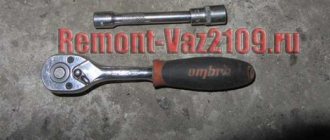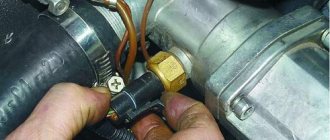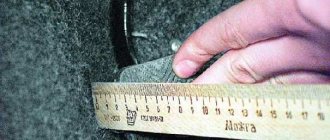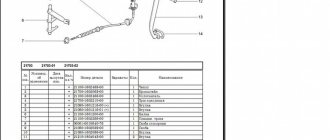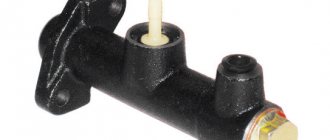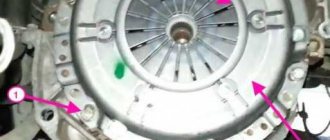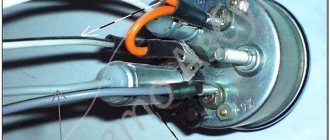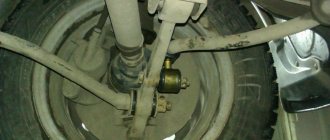Operating principle of the electronic engine control system (ECM)
In a modern car, all process control, except for the rotation of the steering wheel, and even then, is entrusted to the computer, or Electronic Control Unit (ECU). It contains a program with many different tables. In general, the ECU receives data about the state of the car, speed, revolutions, and activated mechanisms from a large number of sensors. Based on the results of these observations, the ECU, using these tables, includes certain ignition modes, fuel supply and other executive functions.
Where is the clutch sensor on the grant?
Replaced the clutch sensor. This sensor is located in the cabin, directly above the clutch pedal. You can say at its axis of rotation (or whatever it is called), in short, where it is attached.
As far as I know and understand, this sensor is only installed on cars with E-gas, but there are no throttle position and idle speed sensors. But all this is answered by E-gas. If I'm wrong, please correct me. The first symptom is that the clutch sensor is dead - Jackie Chan came to visit me. To be honest, I didn’t even do the diagnostics. The most interesting thing is that the check light came on after about 400-500 km, when it started to become really dull. It’s interesting that the sensor started to go dull yesterday. The next day I start it, drive and everything is fine. But over time, everything is new again. Or it could all stop before I got home, and the next day it would start drizzling again in the morning. In short, nothing is clear))).
And it slows down in the following way: when changing gears (let’s say from 3 to 4), you squeeze the clutch and the rpms immediately jump by about 500 (maybe a little more). Or in another way: you are accelerating or driving at one speed and decided to switch, and then when you press the clutch the car itself picks up speed and immediately drops it. But if you first release the gas, then wait 1-2 seconds. and squeeze the clutch, the revs do not jump. And not long before the death of this sensor there was one strange thing. The car started to jerk at low speeds, about 1000-1200 rpm, no matter what gear. I read about this crap on the Internet and decided to change this sensor. By that time, my check had not yet cleared. As soon as I bought the sensor, I drove 300-400 meters away from the market and the check light came on.
Symptoms of this part being faulty
Since this element is connected to the ECU, it reacts to its failure first of all. That is, it gives peculiar signals that are reflected on the instrument panel and are noticeable in the behavior of the Priora when driving.
- turning on the “Check Anger” light;
- twitching when starting to move;
- a sharp drop or, conversely, an increase in speed when the clutch is engaged.
There can be three malfunctions in total: a breakdown of the sensor itself, a break or short circuit in its circuit, and incorrect adjustment of the position of the limit switch on the pedal.
Attention! Only Prioras, which have an electronic throttle, are equipped with such a device. Cars with a regular throttle cable do not have one. It is also available for all-wheel drive VAZ. It must be remembered that these are two types of sensors, and they are not interchangeable!
In general, the “Check” warning lamp lights up in cases where the ECU has not received a signal within 2 seconds when starting from a stop or during four shifts on the move without a signal. Accordingly, the signs mentioned above appear.
Debugg
Alas, as practice shows, at the moment this sensor is not always on sale. But you need to remember that the most common malfunction is the separation of the wire from the limit switch contacts. And they are easy to solder. In general, first you need to visually make sure that the pedal pusher presses properly on the limit switch. Visually check the condition of the wires. And only after that remove it. This is a simple procedure. The clutch sensor is attached with only two self-tapping bolts, and it is not difficult to remove it with a short, shaped screwdriver. Well, then, on the spot, decide whether to start going to retail outlets in search of a new unit, or try to restore the old part. Well, put it in its place. After finishing work on the Priora, do not forget to reset the ECU error memory.
The popular Priora was designed in the spirit of the times, so the computer even controls such a unit as the clutch. The electronics do not control the process of turning the clutch on and off, but the clutch sensor on the Priora, installed under the clutch pedal, collects information about the position of the pedal. This data enters the electronic engine control unit and is used to optimize engine operation depending on the driving mode, and also makes it possible to use cruise control on the car.
Causes of a tight clutch pedal on a Lada Granta car and ways to eliminate the problem
Problems with a hard lever arise both on new cars and on models with an impressive mileage. Depending on the age, the nature of the problem can vary - from a banal drive wedge to serious problems with the unit connecting the engine and gearbox.
What's the matter
Often a tight clutch pedal on a Lada Granta occurs for the following reasons:
- Mediocre performance of the diaphragm spring.
- Fork jamming.
- Release bearing jamming.
- Scratches on the surface of the cable in the working braid.
- The cable is distorted in the mounting bracket to the interior pedal assembly.
- Wedging of the driven disk.
On vehicles with a long service life, cracks may appear in the bearing drive fork and on the release support guide. The accumulation of dirt in the assembly also cannot be ruled out. Damage to the cable clamp bracket should also not be discounted.
For your information. All of these problems can result from the manufacturer allowing defective parts to be installed.
How to troubleshoot
There is no point in immediately positioning the unit connecting the box and the engine as faulty. The cost of a new set of spare parts in the form of a basket, driven disk and release bearing is high, and there will be no 100% certainty that there is a problem with this module until a thorough diagnosis of the drive has been carried out.
How does the electronic engine management system work?
The electronic engine control unit controls most of the vehicle's components, excluding the steering and suspension. ECU programs include presets (tables), according to which optimal operating modes are calculated. Many sensors installed on the car read information about speed, movement, engine speed, activated mechanisms and units. Based on the tables, the ECU changes the ignition mode, turns on additional functions and regulates the composition and amount of the air-fuel mixture entering the cylinders.
Functions of the Priora clutch sensor
Data about the current mode of the clutch mechanism is important for engine control. If the clutch is open, it is necessary to reduce the fuel supply and reduce engine speed. It is optimal to do this in accordance with the current speed of the vehicle, without switching to idle mode. A driver, especially an inexperienced one, may make mistakes, which leads to increased load on the engine and clutch. The on-board computer, based on the readings of the clutch sensor, adjusts the engine operating mode, setting the optimal speed. Also, the clutch sensor on the Priora, in combination with the speed sensor, allows the computer to evaluate the performance of the unit and signal problems.
Installing a clutch sensor on a Priora allowed:
- reduce fuel consumption;
- make driving easier and more enjoyable;
- control the serviceability of the coupling;
- extend clutch life.
Therefore, the serviceability of the sensor affects the service life of the units, fuel consumption and is extremely important for the correct operation of the ECU.
Operating principle of the Priora clutch sensor
What is a Priora clutch sensor? The operating principle of the device is no different from a simple limit switch. When the pedal is not pressed and the clutch is engaged, the sensor contacts are open. When you press the clutch drive, the limit switch closes, sending a signal to the computer to separate the clutch disc and basket.
The clutch sensor is installed on the pedal mounting assembly so that the tip of the pedal touches the limit switch.
The sensor design is simple and reliable, but this does not exclude the possibility of breakdowns and malfunctions in its operation.
Clutch pedal position sensor VAZ
On the latest models of VAZ cars equipped with an electronic gas pedal, a clutch pedal position sensor . Let's consider why it is needed, the principle of operation and possible malfunctions.
Where is the clutch sensor installed on VAZs?
The clutch pedal position sensor on VAZ is installed directly on the clutch pedal bracket; it can be seen by looking under the steering column.
What is a clutch sensor used for?
The clutch pedal position sensor is one of the elements of the engine management system with an electronic gas pedal. This sensor provides a more flexible control scheme for engine modes. It simplifies the process of starting to move, eliminates “drops” and jerks of the car when changing gears in the manual transmission, and also allows for a reduction in fuel consumption.
By providing information to the engine controller about the moment the clutch is engaged and disengaged, the clutch pedal position sensor allows it to reduce or increase engine speed at the right moment, as well as adjust the ignition timing.
Working principle of the clutch sensor
The clutch pedal position sensor is an ordinary limit switch with two positions - “on” and “off”.
Its normal position is open, that is, it turns on only when the clutch pedal is pressed.
Clutch position sensor malfunctions
The following symptoms may indicate a malfunction of the clutch pedal position sensor
- car "pecks" when changing gears
- a sharp increase or decrease in engine speed when the clutch is disengaged
Also, if a malfunction occurs in the clutch pedal position sensor , error 0830 “Clutch pedal sensor error” is recorded in the engine controller and the “Check Engine” light in the instrument cluster turns on.
Error 0830 is detected if the engine controller does not receive a signal from the clutch sensor:
- within 2 seconds after changing gear while driving
- after four gear changes at speeds above 10 km/h and engine speeds above 1000 rpm
The main reasons for error 0830:
- malfunction of the clutch sensor itself
- short circuit or open circuit
- Incorrect clutch pedal height
We encountered error 0830 while preparing the material “How to get there without a clutch?” We recorded video instructions on how to change gears without a clutch. After several gear changes without disengaging the clutch, the “Check Engine” light came on on the panel, which went out only after several dozen gear changes in normal mode.
Clutch sensor price
On many VAZ cars with an electronic gas pedal there is a connector for this sensor, but there is no sensor itself. It is not clear whether they forget to install it at the factory, or whether careless dealers remove it. The second option is also quite possible, since this sensor is still in great short supply. It costs an average of 350 rubles, but finding it on sale is almost impossible.
Replacing the Priora clutch sensor
To dismantle the Priora clutch sensor, you just need to unscrew the two screws holding it to the clutch pedal. But to get to them, you need to do a lot of operations. Removing the Priora clutch sensor is done as follows:
After removing the sensor, you can replace it with a new one or repair it.
The sensor is installed like this:
- secure the sensor with self-tapping screws;
- install the rubber clutch pedal cover;
- install frill;
- secure the windshield wiper blades.
How to replace the clutch pedal sensor Lada Granta
Based on the signal from the clutch pedal position sensor, the controller calculates the pressed and unpressed position of the pedal
When the clutch pedal is pressed, the controller disables engine load regulation.
The location of the clutch pedal position sensor is shown in Figure 1.
Removing the sensor
Remove the wire block holder from the hole in the pedal assembly bracket
Press the block latch and disconnect the sensor wire blocks
Using a screwdriver, remove the hook of the pressure lever spring from the hole in the sensor holder
Using a Phillips screwdriver, unscrew the two self-tapping screws securing the sensor holder to the pedal assembly bracket
Remove the holder with the sensor assembly
Remove the sensor from the two holder rods
Install the clutch pedal position sensor in the reverse order.
Repair of the Priora clutch sensor
Often, sensor malfunctions can be easily resolved without replacing it.
First you need to check whether the sensor end reaches the clutch pedal pusher. If the pusher does not press on the limit switch, it is necessary to adjust the position of the sensor relative to the pedal.
Another common failure is a break in the wires going to the sensor contacts. This malfunction can be easily detected by checking that the wires are securely fixed with your fingers. To fix this problem, you need a soldering iron, solder and rosin. When the sensor is removed from the car, soldering wires to its contacts is not difficult.
If the sensor wires are not broken and the limit switch reaches the pusher, the problem may be a faulty sensor contact or a broken limit switch. They may oxidize, become deformed or break. The functionality of the contacts can be checked using a multimeter. To do this, you need to connect the device to the sensor terminals and check the change in resistance between them when you press the limit switch.
Oxidized contacts can be cleaned, restoring the functionality of the sensor. If this does not work, it should be replaced. The price of this part is low, and you can buy it at most auto stores.
Replaced the clutch sensor. This sensor is located in the cabin, directly above the clutch pedal. You can say at its axis of rotation (or whatever it is called), in short, where it is attached.
This is what the clutch sensor looks like with a wire and a connector.
As far as I know and understand, this sensor is only installed on cars with E-gas, but there are no throttle position and idle speed sensors. But all this is answered by E-gas. If I'm wrong, please correct me. The first symptom is that the clutch sensor has died - Jackie Chan came to visit me. To be honest, I didn’t even do the diagnostics. The most interesting thing is that the check light came on after about 400-500 km, when it started to become really dull. It’s interesting that the sensor started to go dull yesterday. The next day I start it, drive and everything is fine. But over time, everything is new again. Or it could all stop before I got home, and the next day it would start drizzling again in the morning. In short, nothing is clear))).
And it slows down in the following way: when changing gears (let’s say from 3 to 4), you squeeze the clutch and the rpms immediately jump by about 500 (maybe a little more). Or in another way: you are accelerating or driving at one speed and decided to switch, and then when you press the clutch the car itself picks up speed and immediately drops it. But if you first release the gas, then wait 1-2 seconds. and squeeze the clutch, the revs do not jump. And not long before the death of this sensor there was one strange thing. The car started to jerk at low speeds, about 1000-1200 rpm, no matter what gear. I read about this crap on the Internet and decided to change this sensor. By that time, my check had not yet cleared. As soon as I bought the sensor, I drove 300-400 meters away from the market and the check light came on.
And here's a little story about the search for the sensor. The first thing I did was call the store where they sell spare parts from the factory. They said he wasn't there. They constantly give applications for it, but don’t deliver it. Then I called the 2nd office. to dealers. The first one said that it was there. Price 500 rubles, replacement also 500 rubles. Honestly, it’s expensive, both for the sensor and for replacing it. At the 2nd dealer, the price of the sensor is 400 rubles, replacement is 300 rubles. This is more modest.
This is what the sensor itself looks like. The spring is attached differently, not like in the picture. One side to the pedal, and the other somewhere else))
And this is the inside of the sensor. Agree, even 400 rubles is expensive for this.
Still, I decided to go to the market and ask there. Still, it should be cheaper on the market than from the officials. I arrived at the market and approached the first seller I came across. He says that there is and immediately asks how much it costs in other places. I answered him that I didn’t know, so I approached him first. He gives me 500 rubles. I go further, and there: - What kind of sensor is this? – This is the first time I’ve heard about such a sensor. - And what car? This sensor is the same for all cars, including Kalina, Granta, Priora and Samara. This is what I assume about the chepyrka. He should probably be there too. In the 2nd photo you can see the catalog number. - Or here’s an example: “What kind of car?” “On a grant.” “We don’t have anything on a grant.” I wonder if if I had said to a Priora or a Kalina, this sensor would have suddenly appeared? And if I had said something bad, the sellers would have been in a panic, they would have looked at me like I was an idiot, and they would have started to argue and prove that there was no such sensor there. And yet I found it cheaper. For 250 rubles. Of course, the seller asked me which car. Anyway. I decided to change it myself, suffered, suffered, and scored. I went to the nearest service center and changed it for 200 rubles. The service also heard about the sensor for the first time. I showed him the sensor where it is. He took it off quickly, one might say, but it took him a long time to put it back.
Lada Granta clutch pedal sensor
Modern cars are equipped with special electronic clutch pedals, which ensure ease of gear shifting and normalization of the transition to a new engine operating mode.
Like any other element of the system, the pedal has a sensor responsible for transmitting data to the control unit. Irregularities in its operation can lead to surges in speed and unstable operation of the power unit. Therefore, even a new Granta clutch sensor that has failed may require immediate repair.
Where is the clutch sensor located and why is it needed?
A special Grant clutch sensor is attached to the pedal bracket itself. You can see it by looking under the steering column. The stabilizer is a fairly simple design in the form of a limit switch. When not activated, it has the “Off” position. The element is activated only when the clutch pedal is pressed.
The electronic clutch control system ensures correct engine operation and rapid switching to a new mode. When you press the pedal, the stabilizer is activated and transmits the corresponding signal to the control unit.
Thus, the Grant clutch pedal sensor allows you to optimize gear shifting and eliminate speed jumps when changing speed modes, as well as unstable engine operation (jerks).
Grants clutch sensor: how to find out if the element is broken and how to replace it?
A color Check Engine indicator is installed on the front panel of the Granta, which notifies the car owner about a breakdown of the clutch sensor.
The element lights up orange or reddish and indicates the need to check the operation of the pedal and its addition. Problems may also be noticed during sudden changes in speed during gear changes. Such phenomena will indicate one of the following breakdowns:
1. Incorrect position of the pedal relative to the floor (the need to adjust its height).
2. Damage to the pedal sensor.
3. Disturbances in the circuit, incorrect closure of contacts.
Some car owners even complain that the clutch pedal on the Grant clicks
So it’s not the pedal that clicks, but the sensor.
In this video you can see the sensor larger (and the play near it)
The alarm can be replaced independently, but the contractor should remember to be extra careful in performing the work and purchasing the correct sensor. There are two types of elements installed on Lada 4X4 and Grant/Kalina/Priora.
When repairing Granta, you will need part number 1118-3720015, so when purchasing you should follow the index from the catalog. It is worth considering that spare parts can not be purchased from all suppliers, so it is better to immediately contact official dealers.
Once a new Lada Granta clutch sensor has been purchased, you can begin replacement. First you need to remove the terminal from the battery for safe repairs.
Next, you will need to remove the wire clamp from the hole on the pedal bracket (it is pulled out of the hole with some force). Then the front panel harness block and the sensor block itself are disconnected. The spring on the bracket supporting the sensor is pryed up and removed from the element.
Unscrew the two screws on the pedal bracket that secure the signaling device. After removing the side support of the sensor, it is removed from the bracket along with the holder plates.
They will need to be reinstalled on the new meter, after which the previously purchased Grant clutch pedal position sensor can be mounted in the reverse order. The work is not difficult, but requires careful removal of both the spring and the holders themselves.
If performed carelessly, the integrity of the structure may be damaged and the purchase of lost or damaged parts may be necessary.
You may also be interested
Author of all articles on the site! Own service “New Line Auto” All types of work. Specialization: Lada
Description of the brake pedal sensor
Below we will find out how it works and how to replace it.
The essence of the system is that when you press on the brake, the piston in the cylinder begins to move. After this manipulation, fluid enters the brake system from the intake valve. It passes through the pipelines towards the main wheel mechanism, thus creating a suitable situation for the pads to move towards the wheel discs and drums. As a result, contact and subsequent braking occur. The controller itself turns on the brake lights.
When “communicating” with a car, you can encounter various problems, but there is the most common and annoying problem. This problem is called error P0504, or otherwise “Brake pedal sensor mismatch.”
This malfunction often slows down the car. To solve this issue, you need to release the brake pedal and adjust the gap in the position sensor.
The adjustment is quite simple:
- It is necessary to hang a small but weighty weight in the area of the rubber brake pad.
- Unscrew the sensor nut a little and bring the white part to the brake pedal so that there is a gap of 0.2-0.5 mm between the body thread and the white tip. The sensor must be fixed in this position.
Why do you need a clutch pedal position sensor? How to change the clutch sensor on a Priora
Modern cars are equipped with special electronic clutch pedals, which ensure ease of gear shifting and normalization of the transition to a new engine operating mode.
Like any other element of the system, the pedal has a sensor responsible for transmitting data to the control unit. Irregularities in its operation can lead to surges in speed and unstable operation of the power unit. Therefore, even a new Granta clutch sensor that has failed may require immediate repair.
Where is the clutch sensor located and why is it needed?
A special Grant clutch sensor is attached to the pedal bracket itself. You can see it by looking under the steering column. The stabilizer is a fairly simple design in the form of a limit switch. When not activated, it has an “Off” position. The element is activated only when the clutch pedal is pressed.
The electronic clutch control system ensures correct engine operation and rapid switching to a new mode. When you press the pedal, the stabilizer is activated and transmits the corresponding signal to the control unit.
Thus, the Grant clutch pedal sensor allows you to optimize gear shifting and eliminate speed jumps when changing speed modes, as well as unstable engine operation (jerks).
Grants clutch sensor: how to find out if the element is broken and how to replace it?
A color Check Engine indicator is installed on the front panel of the Granta, which notifies the car owner about a breakdown of the clutch sensor.
The element lights up orange or reddish and indicates the need to check the operation of the pedal and its addition. Problems may also be noticed during sudden changes in speed during gear changes. Such phenomena will indicate one of the following breakdowns:
1. Incorrect position of the pedal relative to the floor (the need to adjust its height).
2. Damage to the pedal sensor.
3. Disturbances in the circuit, incorrect closure of contacts.
Some car owners even complain that the clutch pedal on the Grant clicks
So it’s not the pedal that clicks, but the sensor.
In this video you can see the sensor larger (and the play near it)
The alarm can be replaced independently, but the contractor should remember to be extra careful in performing the work and purchasing the correct sensor. There are two types of elements installed on Lada 4X4 and Grant/Kalina/Priora.
When repairing Granta, you will need part number 1118-3720015, so when purchasing you should follow the index from the catalog. It is worth considering that spare parts can not be purchased from all suppliers, so it is better to immediately contact official dealers.
Once a new Lada Granta clutch sensor has been purchased, you can begin replacement. First you need to remove the terminal from the battery for safe repairs.
Next, you will need to remove the wire clamp from the hole on the pedal bracket (it is pulled out of the hole with some force). Then the front panel harness block and the sensor block itself are disconnected. The spring on the bracket supporting the sensor is pryed up and removed from the element.
Unscrew the two screws on the pedal bracket that secure the signaling device. After removing the side support of the sensor, it is removed from the bracket along with the holder plates.
They will need to be reinstalled on the new meter, after which the previously purchased Grant clutch pedal position sensor can be mounted in the reverse order. The work is not difficult, but requires careful removal of both the spring and the holders themselves.
If performed carelessly, the integrity of the structure may be damaged and the purchase of lost or damaged parts may be necessary.
Depending on the position of the clutch pedal and the brake signal switch, the controller is able to distinguish the position of the pedals. In this article, special attention will be paid to the Kalina brake pedal sensor, as well as the clutch sensor.
Description of the brake pedal sensor
Below we will find out how it works and how to replace it.
The essence of the system is that when you press on the brake, the piston in the cylinder begins to move. After this manipulation, fluid enters the brake system from the intake valve. It passes through the pipelines towards the main wheel mechanism, thus creating a suitable situation for the pads to move towards the wheel discs and drums. As a result, contact and subsequent braking occur. The controller itself turns on the brake lights.
When “communicating” with a car, you can encounter various problems, but there is the most common and annoying problem. This problem is called error P0504, or otherwise “Brake pedal sensor mismatch.”
This malfunction often slows down the car. To solve this issue, you need to release the brake pedal and adjust the gap in the position sensor.
The adjustment is quite simple:
- It is necessary to hang a small but weighty weight in the area of the rubber brake pad.
- Unscrew the sensor nut a little and bring the white part to the brake pedal so that there is a gap of 0.2-0.5 mm between the body thread and the white tip. The sensor must be fixed in this position.
Diagnostic features
In order to diagnose the operation, you must first ring the contacts individually, and then in pairs. If contacts 2 and 3 ring muffledly, this may indicate a malfunction, especially considering that the remaining contacts make loud sounds (video author - Stas's Garage).
Instructions for replacing the brake controller
- Pump out the liquid.
- Place the vehicle on a support stand and remove the wheel.
- Use a wrench to unscrew the two wheel pins.
- Remove the brake drum.
- Then, using a screwdriver, pull out the hook of the upper tension spring and remove the part. Perform the same manipulation with the lower tension spring.
- Then remove the front pad and spacer bar, while disconnecting the pressure spring and lower the pad.
- Remove the shoe lever from the parking brake hole, straighten the cotter pin and remove it from the parking brake drive.
- Remove the washer and
Instructions for replacing the brake controller
- Pump out the liquid.
- Place the vehicle on a support stand and remove the wheel.
- Use a wrench to unscrew the two wheel pins.
- Remove the brake drum.
- Then, using a screwdriver, pull out the hook of the upper tension spring and remove the part. Perform the same manipulation with the lower tension spring.
- Then remove the front pad and spacer bar, while disconnecting the pressure spring and lower the pad.
- Remove the shoe lever from the parking brake hole, straighten the cotter pin and remove it from the parking brake drive.
- Remove the washer and lever.
- Install a new block and assemble the part in the reverse order.
REPLACING THE CLUTCH SENSOR — LADA GRANTA Blog
Removing the clutch pedal position sensor
Remove the clutch pedal position sensor to replace it. The sensor is located in a hard-to-reach place under the instrument panel, so most of the operations for dismantling the sensor are shown on the removed pedal assembly for clarity.
Location of the clutch pedal position sensor. Before disconnecting the sensor wiring connector from the instrument panel wiring harness...
...remove holder 1 of the sensor wire block from hole 2 in the pedal assembly bracket. By pressing the clamp of the instrument panel wiring harness...
...disconnect the wiring harness block from the sensor wiring block.
Using a screwdriver, remove the hook of the pressure lever spring from the hole in the sensor holder.
Using a Phillips screwdriver, unscrew the two self-tapping screws securing the sensor holder to the pedal assembly bracket...
...and remove the holder with the sensor assembly.
Remove the sensor from the two holder rods.
Clutch pedal position sensor Install the clutch pedal position sensor in reverse order
Description of the clutch pedal sensor
What kind of device is this and how to replace it is below.
Purpose, location and operating principle
The clutch sensor is installed directly on the clutch pedal. It influences engine control with an electronic gas pedal and provides a convenient and flexible control scheme for machine modes. On its own, it looks like a nondescript switch that has on and off modes.
Typical malfunctions and methods for their elimination
If the controller does not detect signals from the clutch, then there is a risk of error 0830. The occurrence of this problem is usually a malfunction of the clutch sensor or a short circuit or open circuit. To correct this state of affairs, it is necessary to identify the reasons. That is, inspect the contacts for breaks or corrosion.
Clutch pedal sensor Grant, Priora, Kalina 2, Datsun (E-GAS)
Dear customers, in order to avoid errors when sending the clutch pedal sensor, please indicate your car model and year of manufacture in the “Comment” line.
Modern cars are equipped with special electronic clutch pedals, which ensure ease of gear shifting and normalization of the transition to a new engine operating mode.
The clutch pedal position sensor is one of the elements of the engine management system with an electronic gas pedal. This sensor provides a more flexible control scheme for engine modes. It simplifies the process of starting to move, eliminates “drops” and jerks of the car when changing gears in the manual transmission, and also allows for a reduction in fuel consumption.
By providing information to the engine controller about the moment the clutch is engaged and disengaged, the clutch pedal position sensor allows it to reduce or increase engine speed at the right moment, as well as adjust the ignition timing.
The clutch pedal position sensor is an ordinary limit switch with two positions - “on” and “off”. The circuit consists of a normally open sensor, a clutch pedal position sensor signal circuit, and a sensor ground circuit.
Its normal position is open, that is, it turns on only when the clutch pedal is pressed.
The clutch pedal position sensor kit 1118 –3720015 includes:
— switch 1118-3720015-00 — 1 pc.;
— protective casing 1118-3720024-00 — 1 pc.;
— fastening screw 1-0076690-01 — 2 pcs.;
— spring 1118-1602179-00 — 1 pc.
The clutch pedal position sensor on VAZ cars is installed directly on the clutch pedal bracket; it can be seen by looking under the steering column.
It would seem like a simple sensor, but how much it can complicate the life of an ordinary car owner.
The following symptoms may indicate a malfunction of the clutch pedal position sensor:
— car “pecks” when changing gears;
— a sharp increase or decrease in engine speed when the clutch is disengaged;
— error 0830 “Clutch pedal sensor error” is recorded in the engine controller and the “Check Engine” light in the instrument cluster turns on.
Error 0830 is detected if the engine controller does not receive a signal from the clutch sensor:
— within 2 seconds after changing gear while driving;
— after four gear changes at speeds above 10 km/h and engine speeds above 1000 rpm;
The main reasons for error 0830:
— malfunction of the clutch sensor itself;
— short circuit or open circuit;
- Incorrect clutch pedal height.
There are two types of clutch pedal position sensors for VAZ cars:
For Kalina 2, Granta, Datsun, Kalina and Priora cars with an electronic gas pedal - 1118-3720015-00
For Lada 4×4 cars with electronic gas pedal 21214-3720020-02
They are not interchangeable with each other.
Other articles of the product and its analogues in catalogues: 11180 372001500.
VAZ 1117-1119, VAZ 2170, VAZ 2190, Kalina 2, Datsun, Largus.
